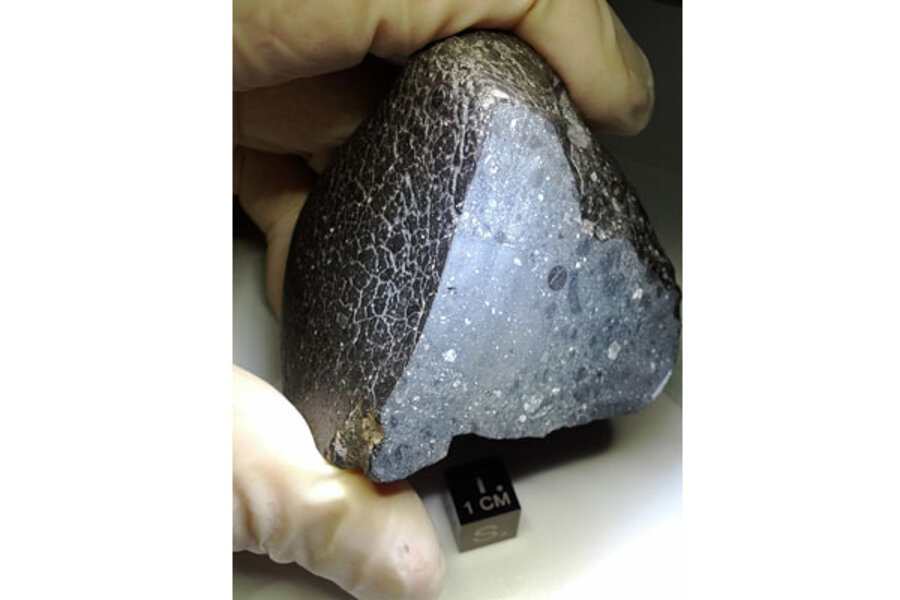Odd meteorite could be time capsule of a wetter Mars
Loading...
An unusual meteorite plucked from the Moroccan desert holds the potential to open a window on a critical period in the history of Mars, when the planet was undergoing a dramatic change from warm and wet – conditions potentially hospitable to life – to cold, dry, and desolate.
Unlike any Martian meteorite scientists have studied so far, the new object, tagged as NWA 7034, has a composition similar to the planet's crust. Indeed, the sample is similar to rock and soil samples seen by rovers Spirit and Curiosity – the first time scientists have been able to link a meteorite to rocks analyzed on the surface of the red planet, according to a team from the US and China formally reporting its results in Friday's issue of the journal Science.
It is the 2 billion-year-old meteorite's volcanic origin and its apparent interactions with water and the atmosphere at or near the Martian surface that may have turned it into such an intriguing a time capsule.
"Having this sample from 2 billion years ago may give us a little bit of a glimpse of what the surface conditions were like" during a poorly understood period in Mars's history, says Carl Agee, the team's leader and director of the Institute for Meteoritics at the University of New Mexico in Albuquerque.
The rock was formed during the early years of Mars's Amazonian epoch. The epoch is thought to have started between 3.5 and 1.8 billion years ago and was marked, among other things, by the formation of the solar system's largest volcano, Olympus Mons, as well as by volcanic activity elsewhere on the planet.
The 11-ounce meteorite's mix of minerals and its rubble-like composition speak to a violent beginning – rising toward the surface in an explosive, Mt. St. Helens-style volcanic eruption, Dr. Agee says.
Surprisingly, the meteorite boasts some 10 times the water of other, younger Martian meteorites, although the amount is still tiny. The team initially estimated that the meteorite held up to 3,000 parts per million in water, half of which the rock accumulated after landing on Earth. Further measurements, however, showed that the rock held up to twice the water the team initially calculated. And virtually all of it was of extraterrestrial origin, Agee says.
Moreover, the measurements suggested that the meteorite's water came from at least two sources – magma and water at or near the planet's surface. This water, perhaps melted permafrost or a surface pool, reacted with the rock while it was still too hot to handle.
NWA 7034 also hosts complex organic molecules, which can have biological as well as nonbiological sources.
Other Martian meteorites have contained polycyclic aromatic hydrocarbons, which had nonbiological origins. The team is now examining NWA 7034's nonbiological organic molecules to see if they are similar to those found in earlier Martian meteorite samples, writes Andrew Steele, an astrobiologist at the Carnegie Institution for Science in Washington, in an e-mail exchange. [Editor's note: This paragraph, as well as the one preceding it, have been revised to better reflect the analysis that Dr. Steele is conducting.]
Ongoing research aims to use the rock's interaction with cosmic rays to determine how long it took to reach Earth from Mars. Nor have they yet pinned down the length of time it sat in the desert before a meteorite hunter picked it up in 2011. Based on the amount of weathering the specimen displayed, Agee estimates that NWA 7034 might have landed several hundred years ago.
Colleagues are also cataloging the relative abundance of gases trapped in tiny pockets to tease out clues as to the makeup of the planet's atmosphere at the time the rock reached the surface.
“The contents of this meteorite may challenge many long held notions about Martian geology,” said John Grunsfeld, associate administrator for NASA’s Science Mission Directorate in Washington, in a statement. “These findings also present an important reference frame for the Curiosity rover as it searches for reduced organics in the minerals exposed in the bedrock of Gale Crater.”





